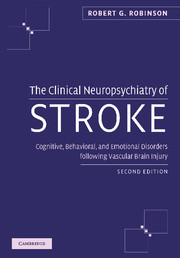 The Clinical Neuropsychiatry of Stroke
The Clinical Neuropsychiatry of Stroke Book contents
- Frontmatter
- Contents
- Preface
- Part I Introduction
- Part II Poststroke depression
- Part III Poststroke mania
- Part IV Poststroke anxiety disorders
- Part V Other poststroke disorders
- 34 Psychosis
- 35 Anosognosia and denial of illness
- 36 Catastrophic reaction
- 37 Apathy
- 38 Disturbance of prosody
- 39 Irritability and aggression
- 40 Pathological laughing and crying
- 41 Summary and future directions
- Index
35 - Anosognosia and denial of illness
from Part V - Other poststroke disorders
Published online by Cambridge University Press: 01 October 2009
- Frontmatter
- Contents
- Preface
- Part I Introduction
- Part II Poststroke depression
- Part III Poststroke mania
- Part IV Poststroke anxiety disorders
- Part V Other poststroke disorders
- 34 Psychosis
- 35 Anosognosia and denial of illness
- 36 Catastrophic reaction
- 37 Apathy
- 38 Disturbance of prosody
- 39 Irritability and aggression
- 40 Pathological laughing and crying
- 41 Summary and future directions
- Index
Summary
In 1914, Babinski (1914) reported that some patients with severe hemiplegia appeared to be unaware of their deficit. He called this absence of awareness “anosognosia,” a term derived from the Greek words “gnosis” (knowledge), “a” (without), and “noso” (disease). The medical literature of the late 19th and 20th centuries reported a variety of failures of awareness of one's own deficits or diseases including Anton's syndrome of cortical blindness (Anton 1896), unawareness of hemianopsia, amnesia, dementia, aphasia (particularly fluent aphasia), and mental illnesses like schizophrenia or dementia.
As they are unaware of their illness, patients with anosognosia may be less likely to seek treatment and remain compliant with prescribed medications. They may also engage in potentially dangerous activities based on their belief that they are able to do things that they are not, such as believing themselves capable of driving an automobile when they are not (Heilman and Valenstein 1993). Clinicians, therefore, should monitor their patients' awareness of their limitations.
Denial of illness is similar to anosognosia because patients fail to acknowledge their illness or deficits associated with it. Denial of illness has been reported among patients with brain injury as well as patients without brain injury (Weinstein and Kahn 1955). When stroke patients deny hemiplegia or sensory deficit, the distinction between denial and anosognosia is negligible.
- Type
- Chapter
- Information
- The Clinical Neuropsychiatry of StrokeCognitive, Behavioral and Emotional Disorders following Vascular Brain Injury, pp. 366 - 382Publisher: Cambridge University PressPrint publication year: 2006


